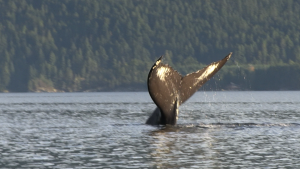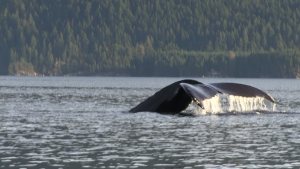 Terry, Jamie and I are perched together on rocks as far out as we can get at low tide waiting for the whales to come around to our side of the inlet. Jamie, who knows their routine, is sure they will make their usual circle and cruise by our campsite. It is dusk already. We can see 2 or 3 whales out in the middle of the inlet. Some of the resident sea lions seem to be playing around them but the light is fading.
Terry, Jamie and I are perched together on rocks as far out as we can get at low tide waiting for the whales to come around to our side of the inlet. Jamie, who knows their routine, is sure they will make their usual circle and cruise by our campsite. It is dusk already. We can see 2 or 3 whales out in the middle of the inlet. Some of the resident sea lions seem to be playing around them but the light is fading.
These dark cloudy nights aren’t the best for transcendent visions of whales breaching in the moonlight. We can’t conjure a 3D CGI humpback bursting from the ocean in fountains of phosphorescence like the scene in “Life of Pi”. So I sit on the rocks in the light drizzle and wait, one arm extending an umbrella over the microphone I’ve wedged between rocks, the other arm draped in mic cable, listening to the waves in my headphones.
Now! Out of the blackness, Pooooooocccchhhhhh! tyuuuuuuuuuuuuUUUUUUUuuuuuu! Through headphones the sound is electrifying! The whales could be almost on top of me! Thrills shoot up my back and hairs shoot out my neck. I’ve been plugged into a live electric socket. Their outbreath is a gale-force gust and their inbreath bugles like a herd of bull elk. They aren’t even singing, just breathing and the music is awesome. We sit erect, enthralled by oceans of whale breath across eons of time. The whole universe is whales.
Sound of whale blow and “bugle” inbreath. Increase ||||||| for more volume
The next morning we are in citizen science mode. Who are the whales we are seeing and hearing? As many as five humpbacks have been feeding and frolicking in the waters between Vancouver Island and the Sunshine Coast. It would be useful to researchers if we could identify them. The best way to do this is to photograph their tail flukes.

Tail fluke patterns are unique to every individual whale, like human fingerprints. There is a catalog of tail fluke photos that researchers have been compiling for decades. If we can get clear enough photos to identify the whales we are seeing we can find them in the catalog. This is easier said than done. Tails don’t pose for photos before disappearing after a diving whale body.
 Being positioned at a good angle while close enough to capture detail is a challenge. However, if we can identify our whales, we might be able to find them again at their southern migration points in Mexico, Hawaii or even Japan.
Being positioned at a good angle while close enough to capture detail is a challenge. However, if we can identify our whales, we might be able to find them again at their southern migration points in Mexico, Hawaii or even Japan.
Blissful visions of snorkeling in warm, clear waters surrounded by relaxed mother humpbacks with curious calves while upside down males saturate the water with reverberating song temporarily transport me. I forget the cold rain dribbling down my neck and dream of tropical whale paradises.
There has been exciting news: a Mom and a calf have been in the area. A friend who was fishing while drifting in his little runabout, had to bang on its gunwhales to ensure the Mom and calf noticed he was there when they surfaced right beside him.
We are sending out psychic invitations to the whales to come around and visit us when we spot 2 whales heading up our side of the inlet. They aren’t wasting any time so we launch our 9ft. inflatable, row out from shore, and drift. Here they come! passing about 30m in front of us. I hold the dinghy in a good position while Terry wrestles the camera from the dry bag. He manages to capture some video as they cruise past.
It’s a good day.
